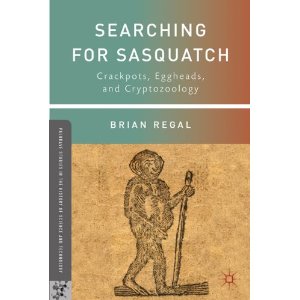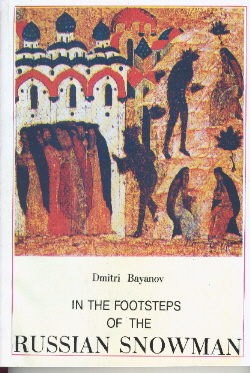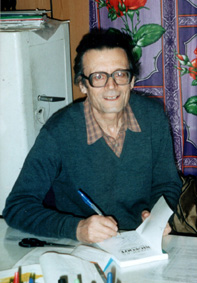Bayanov Blasts Regal Broadside
Posted by: Loren Coleman on October 17th, 2011

In 2011, there appeared a book entitled Searching for Sasquatch: Crackpots, Eggheads, and Cryptozoology by Brian Regal, from Palgrave Macmillan. It was clearly a skeptical debunker’s view of the world of hominology by an academic. Regal surfaced again last week, to address what he called the “shenanigans currently going on in Russia.”

Brian Regal
The article in The Guardian was headlined “Yeti hunters must be more scientific,” with a subheading, “Russian cryptozoologists claiming to have evidence of the yeti will never be taken seriously without a more academic approach.”
Among several statements, Regal shared these quoted thoughts: “A common complaint among cryptozoologists – those who pursue unknown or folkloric monsters – is that mainstream science does not take their work seriously and inappropriately labels it as pseudoscience.”
“One of the things the Russia monster project illuminates is the difference between science and pseudoscience: between real and fake science; between professional scientists and amateur investigators.”
“There are a number of cryptozoologists who work diligently at being properly scientific. They go about their work with intelligence as well as energy. While mostly amateurs, they embody the essence of the scientific endeavour: search the unknown. They, however, are regularly undermined by their less academic brethren. This condition shows that rather than mainstream science it is cryptozoologists themselves who often toss the monkey wrench (or should we say yeti wrench) into the works.”
“If the Yeti or Bigfoot or any of their kin do exist out there, someday they will be found, and likely by an amateur rather than a professional scientist. If that day arrives all of us sceptics will have to rethink our positions. Until then, if cryptozoologists want to be taken seriously by scientists they need to behave more like scientists and less like carnival barkers. Keep the circus to a minimum until you actually have a yeti to show the world, then respect will come.”
(The full article is available here.)


Dmitri Bayanov. Photo credit: Daniel Perez, 2001.
In rebuttal to Regal, Dmitri Bayanov of the International Center of Hominology in Moscow, Russia, has forwarded the following exclusively to Cryptomundo to be published as an answer to The Guardian piece:
++++++
Dr. Regal,
I am short of words to express how wrong I find your broadside published in The Guardian. It takes a specialist in meteoritics to verify whether a stone fell from heaven or is of earthly origin. It takes a paleontologist to verify a fossil. And it takes a hominologist to verify, for example, whether a subject on film is a Sasquatch or a disguised Homo sapiens. This follows from the fact that the Patterson-Gimlin documentary was labelled “fake” by anthropologists and zoologists, and proved authentic by hominologists (anyone who can prove that the label “fake” is correct will receive $100,000; see Bigfoot Research: The Russian Vision, 2011, p.152).
Conclusion: all non-hominologists, both scientists and laymen, are amateurs as regards hominology. Please take note of this: you and all scientists who have not devoted years to a study of our subject in depth are amateurs in hominology. Therefore your deliberations on our subject are pseudoscientific and putting things upside-down.
You pass it in silence that science, as taught by Thomas Kuhn, is divided into normal and revolutionary. “Normal science, for example, often suppresses fundamental novelties because they are necessarily subversive of its basic commitments” (Thomas Kuhn). A few illustrations of such suppression in our case:
Dr. John Bindernagel (Canada) , wildlife biologist, author of two books on the sasquatch, and a participant in what you dubbed “The shenanigans currently going on in Russia”, has this to say in his first book: “In my own case I used to be very concerned about how my interest in the sasquatch, if made public, would affect my reputation as a wildlife biologist, and hence my employability. When, after almost twenty-five years of research, I had reviewed enough evidence to be certain about the existence of the sasquatch, I finally came ‘out of the closet’ with my interest in this species. Long-standing concerns about keeping a low profile on the subject — which still surface in certain situations — keep me sensitive to the feelings of reluctant observers reported to have seen a sasquatch” (North America’s Great Ape: the Sasquatch, 1998, p.20).
Dr. Bindernagel’s present complaint is that he is denied possibilities of speaking publicly on our subject at mainstream science forums.

Dmitri Bayanov, John Green, and Grover Krantz at the Darwin Museum, October 1997, with an image of Bigfoot Bulletin editor George Haas.
The late Dr. Grover Krantz had also problems in his career because of his interest in sasquatchery. He wrote: “There are many younger scientists who are interested in sasquatch, though most of them are still keeping a low profile for now. (…) For now, one of my functions has been to serve as a role model for them, showing that one can get by with this kind of research. But I also show them the price that must be paid for doing it. (…) Back in 1970 I had only a rough idea of the trouble that could result from openly working on this subject, but I didn’t expect it to last more than a few years. My first shock was to be deferred on tenure for one year, in spite of the fact that I was already more frequently cited for normal work than most of the other members of the department. (…) Much later, when my promotion to full professor was denied, the only reason the dean could come up with was that my work was not favorably received in all quarters. (By this criterion, Charles Darwin and Albert Einstein could not possibly have gotten this promotion at my university). (…) Some of my colleagues have pointed out that if I just laid off the sasquatch and kept my ‘nose clean’ for a few years, the promotion would come through and then I could do anything I wanted. My response was that I am doing what I want right now, so the only thing that procedure would accomplish is to cost me a few years’ work” (Big Footprints, 1992, pp.240-42).
Dr. Jeff Meldrum has also known pressure of this kind. This is in largely democratic North America. As for the totalitarian Soviet Union, after the subverted and falsified 1958 Pamir expedition (Marie-Jeanne Koffmann has the full story), Boris Porshnev’s adversaries launched a counter-attack, scientific publication and mainstream forums became forbidden to us (remain so now), and Porshnev died of a heart attack when publication of his book was banned.
That’s what concerns relations with mainstream science. As to long-term witnesses, the BF contactees, the habituators and befrienders, who are the best hope for breakthroughs in hominology, they also experience grave problems from mysterious human attackers, who steal or destroy recorded evidence, vandalize the habituators’ property and disrupt friendly contacts with sasquatches. These shenanigans are described in some published books.
Such is the real picture and situation in and around hominology. It’s rather different from yours.The media hype and numerous hoaxes are the direct result of the abnormal, actually anti-scientific stance of the scientific establishment regarding this matter.There is definitely a taboo and cover-up at the highest level. To “keep the circus to a minimum”, or better put it to an end, the attitude of the scientific community to this subject must change radically.This can only happen if it’s provided with true information possessed by hominologists, instead of misinformation supplied by you and other non-hominologists.
The names you use (“monster enthusiast”, “monster hunters”, “monster project”) show your disrespectful and mocking attitude toward this most important subject. Thus you are more of a scoftic than skeptic. You have either to back up and substantiate your criticism with concrete arguments and examples regarding our research, including my books and articles, or pronounce “mea culpa”. To make your task easier, I offer here a link to my online article (“Thoughts on The Revolution in Anthropology“) and provide in attachment my address at the conference in the Darwin Museum, October 5. Please state what you find wanting or faulty in them. If you accept what I say there, peace can be restored.
Dmitri Bayanov
International Center of Hominology
Moscow, Russia
++++++++++
About Loren Coleman
Loren Coleman is one of the world’s leading cryptozoologists, some say “the” leading living cryptozoologist. Certainly, he is acknowledged as the current living American researcher and writer who has most popularized cryptozoology in the late 20th and early 21st centuries.
Starting his fieldwork and investigations in 1960, after traveling and trekking extensively in pursuit of cryptozoological mysteries, Coleman began writing to share his experiences in 1969. An honorary member of Ivan T. Sanderson’s Society for the Investigation of the Unexplained in the 1970s, Coleman has been bestowed with similar honorary memberships of the North Idaho College Cryptozoology Club in 1983, and in subsequent years, that of the British Columbia Scientific Cryptozoology Club, CryptoSafari International, and other international organizations. He was also a Life Member and Benefactor of the International Society of Cryptozoology (now-defunct).
Loren Coleman’s daily blog, as a member of the Cryptomundo Team, served as an ongoing avenue of communication for the ever-growing body of cryptozoo news from 2005 through 2013. He returned as an infrequent contributor beginning Halloween week of 2015.
Coleman is the founder in 2003, and current director of the International Cryptozoology Museum in Portland, Maine.










TOUCHÉ, Sir!
At least we are in good company. Scientists denied the existence of huge rogue waves for decades, saying that the stories told by sailors were merely exaggerations. They used computer modeling to “prove” that waves over 15 meters were exceptionally rare occurring probably once every 10,000 years. Once the technology to detect those waves was available those computer derived “facts” were proven to be completely wrong with rogue waves occurring on a regular basis. Scientists have proven time and again that the majority of them do not want to see new ideas and theories but prefer to coast along, building on what they “know” to be true. Luckily, there have always been those willing to brave the unpleasant consequences of swimming against the mainstream current to new shores of knowledge.
The remark about the 1958 Pamir expedition sounds particularly interesting. It’s an area in Central Asia I have always wanted to tackle myself, if I could only solve the logistics problems.
I didn’t see anything particularly inflammatory in what Dr. Regal said. I don’t know enough about the Russian researchers, but I question their focus on Bigfoot contactees and habituators (i.e. carter farm and such). If any of these tales should be true, we would at least have a decent picture. I have much respect for Meldrum and Bindernagel though and would love to hear a detailed report from both of them concerning this ‘indisputable proof’ found in Russia. Is it just me, or does anyone who claims they have indisputable proof seem suspect?
The only “indisputable” proof would be an actual body.
Well said Dr. Regal! The proof is certainly in the reality television show. Too many shows today are built on nothing more spot evidence, incredulous sitings and more. For anyone to take the field seriously, it must be treated in the manner that any science would.
I quite appreciate Brian Regals article in the guardian though it is in my opinion a bit half baked. At least he is given Bigfoot attention. One feels he could easily swing his work much more positively towards a better balanced position. In the matter of pseudo science it is everywhere and is found no more than can be expected in cryptozoology than in other arenas. There are some beauties in documentary television. As in Regals work, where scientific criteria is not demanded of him just reason and commons sense and some knowledge, so it is (imo) with most cryptozoologists and if the world demands madam science then they should get it off scientists.
Now if many scientists are too squeamish to get involved because of all the shennigans that go on or until super proof is presented to them on a plate then they are failing not the mostly amateurs that get most of the criticism. Brian Regal is just following a well beaten track in much of his criticisms. It is scientists who should be asked for science, which is available from certain experts, unfortunately they tend to get ignored.
The Regal article seemed to be based on what happened on the recent Russian expedition. I am not sure the hyperbole in the news papers whas the fault of the Russian researchers as their work seemed to have been hijacked for business purposes? In any case cryptozoology in general did not countenace the reports and quickly put them in the sin bin, at least until more imformation comes to light. So the inference of the guardian article seems to be an unfair one.
Dimitri Bayanov and his fellow researchers are a real cryptozoological treasure and do not seem to be fully appreciated outside of russia. They do have a wonderful chance in that vast country to come up with news of at least one relic homonid and I hope thay can bring it off. I can understand his complaints thay do unfortunately make sense but perhaps not full justified by the guardian article.
Dr. Dmitri Bayanov, An absolutely fantastic response, I hope Regal learns a thing or two about being more responsible in doling out his criticisms. I would also like to point out that people who criticize those who search for “hidden hominids” should look at their own lives. If some Cryptozoologists are flawed in their use of scientific methods, what does that make someone who would write a book criticizing them and said methods? Innovation and following all possible paths to an answer is quite necessary in searching for any unknown, as it is and has been in the past and present. Honestly, does this guy have nothing better to do? And a university funds and supports Regal’s brand of “research,” while another prevents a respected professor from getting tenure for a year? I would like to see the sales figures for such a book as compared to one which supports ‘Hidden hominid” ideas….. I bet they are pretty low (at least I hope they are). Anyways, Thanks Dr. Bayanov!
WORD.
Brian Regal was a speaker at this year’s Fortean Times Unconvention. He said he feels himself to be part of the “loyal opposition” and that he doesn’t think Bigfoot exists, although he does think we should be searching for cryptids and wants the search to continue. OK, fair enough. What’s your explanation for the pretty consistent pattern of sightings, then? It will be mega science-y, right?
I asked him what he thought could be triggering the reports that continue to this day. His answer? “I don’t know.” He went on to say that he’s a Jersey boy, not a woodland type, and he thought they might be sightings of bears.
Mystery solved! It’s bears, guys! Crafty bears conspiring to deceive us dumb rural types, probably.
I kind of couldn’t believe that the dude wrote a book on this theme, is employed as a scholar and yet had apparently given very little thought to what ELSE could explain the existing data before concluding that these things don’t exist. That is not usually what is meant by academic rigour. I gave him an opening to drop some kind of opposing-theory bomb on the phenomenon, but no. We got bears instead.
He also claimed that Grover Krantz went into Bigfoot research because he knew he wouldn’t be hugely successful in the main streams of his academic field. Does anyone know if this is true (if anyone ever sees this late comment)? Seems like a rather uncharitable thing to say unless you’ve got good sources to back it up. Maybe he does, but if finding out would involve me reading his book, I think I’ll just have to live with the uncertainty.